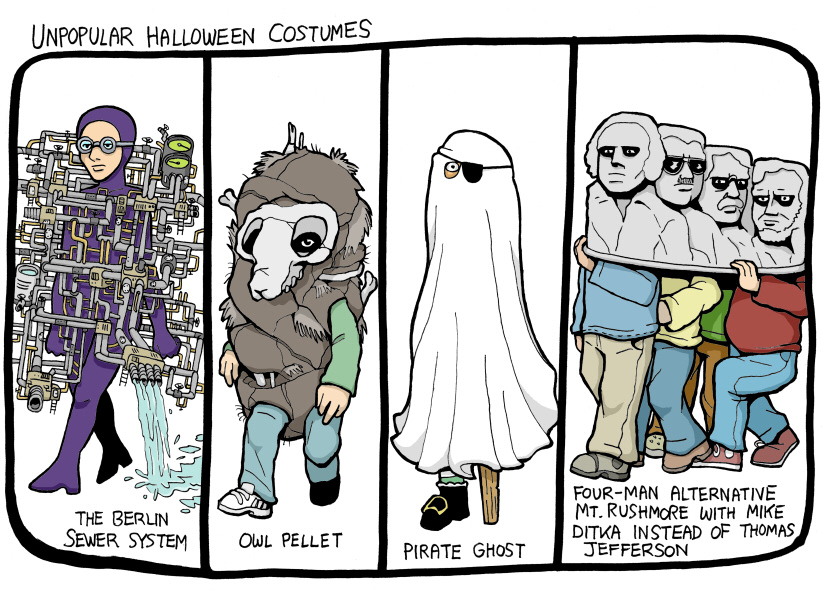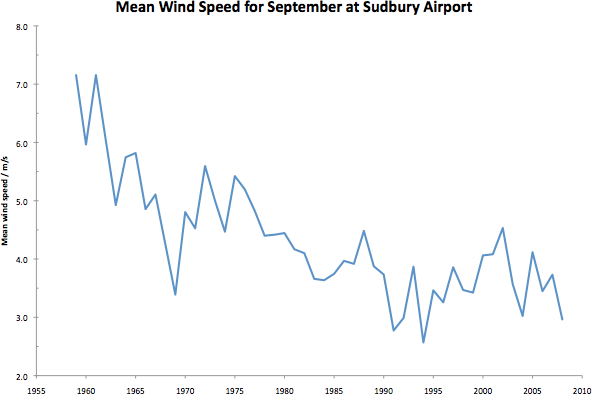This is one of the last surviving garden spiders. It’s huge – perspective makes it look smaller than my thumb, but it’s about the same size.
It looks weary and arthritic. May not see november.
work as if you live in the early days of a better nation
This is one of the last surviving garden spiders. It’s huge – perspective makes it look smaller than my thumb, but it’s about the same size.
It looks weary and arthritic. May not see november.

— from the ever-wonderful SUBNORMALITY!
I’ve mentioned the beautiful drone in the Loblaw Superstore before, but only last night did I actually get around to recording it:
You should probably listen through headphones or decent speakers – there’s some bass in there. If you can, try to experience it for yourself. The store is at 1775 Brimley Road, just south of the 401.
My Marantz PMD-620 has a reliable internal clock, and stamps the files with the time that recording stopped. File times are remarkably fragile, so I wanted to make sure that the times were preserved in the file name. Perl’s rename utility does this rather well, as it allows you to use arbitrary code in a rename operation. So:
rename -n 'use POSIX qw(strftime); my $mtime=(stat($_))[9]; s/.WAV$//; $_ .= strftime("-%Y%m%d%H%M%S",localtime($mtime)); s/$/.WAV/;' *.WAV
which, for files 1007.WAV and 1008.WAV recorded last night, results in:
1007.WAV renamed as 1007-20091024192436.WAV
1008.WAV renamed as 1008-20091024193438.WAV
To actually rename the files, remove the -n from the command line. I left it in so you couldn’t blame me for b0rking up your files if you typed first, thought later.
There are probably smarter ways to handle the file extension. This works for me. Perfection comes later.
I am in oakwood village library, trying WordPress for BlackBerry.
Harry writes:
As you may have heard, the historic dictionary firm of Chambers in
Edinburgh is threatened with closure by the parent company Hachette
Livre.
They intend moving the English dictionaries to London and the
bilingual Harrap titles to Paris, involving not just the loss of 27
jobs in Edinburgh but the end of a publishing tradition going back
nearly two centuries. Chambers is a Scottish and British institution
dear to the hearts of word-lovers.
Yes, the advent of free resources on the internet has changed the
world of reference publishing, but it is far from clear whether all
options for the future of Chambers Harrap have been properly
considered in what appears to be a very drastic and possibly even
underhand move by Hachette. I feel strongly we shouldn’t just accept
this as inevitable. Hachette should be forced at the very least to
undertake a properly full and open review of the situation first, in
due consultation with the NUJ. If you wish to join with others in
urging them to think again, you may like to sign the online petition
at http://www.ipetitions.com/petition/chambers-in-edinburgh/. It only
takes a few seconds.
More at http://sn.im/chambersharrap and http://harrycampbell.blogspot.com.
I missed my old Pentax MX. Of all of the cameras I’ve ever owned, it was probably the one with the most charm – and I don’t mean that in the same way that former Eastern bloc cameras were “charmingly” unreliable.
The MX doesn’t do much, but does all you need. It is tiny, but it’s a very solid chunk of metal. The shutter/mirror makes a very civilized little klipp! when fired. All the controls are where you’d expect them. The pancake 40mm lens gives my MX a snub-nosed appearance. I used to have the bigger and heavier 50mm f/1.4, which some lens nerds consider to be one of the finest lenses ever made.
Sure, it has its faults. The advance lever will poke you in the eye if you change shutter speed on the fly. And, well, y’know, film.
Saw a forces type wearing CADPAT on the subway. He looked like old-school 8-bit, so I thought I could improve on the design:
An empty whisky bottle tube struck hard against the tiled floor: interesting doinks [wav].
When I first heard of Alvin Lucier‘s “I Am Sitting in a Room” I thought it would be interesting to attempt a recreation with the tools I had on hand. Rather than shuffling tapes around, I recorded on my iPod Touch, and then e-mailed the file to my laptop to play back. I repeated this sixteen times. This is what I ended up with: my name is not alvin [mp3].
I’m pretty sure all I ended up recording was the hard drive and the backlight on my MacBook. By the final iteration, the cricket-like chirping is centred pretty close to 5400 and 16000 Hz.
vCard Splitter used to be teh way to split up the huge vCard file that Apple Address book creates. But it doesn’t work under Snow Leopard, but I discovered this tip from Apple: To create multiple vCards at the same time, hold the Option key when dragging multiple cards out of the Address Book window.
To export all your contacts as separate vCards, select them all, hold down ‘Option’, and drag them to a folder in Finder. It would really help if this wasn’t the Desktop folder, unless you like major cleanups …
When I was first involved in the industry in Ontario, every developer had a monitoring tower in Sudbury. Sudbury was going to be the wind energy capital of Canada. And then, suddenly, it wasn’t.
This is a half-remembered summary of a talk given by Jim Salmon at CanWEA 2009. I’m sure I’m missing bits, but the proceedings will come out eventually.
The first wind map of Canada, published in the early 1990s, showed phenomenal wind speeds over Sudbury. We’re talking wind-over-open-water speeds. The weather station at Sudbury airport could pretty much have been a wind farm.
Sudbury, for those that don’t know, is the centre of Ontario’s nickel mining. The city used to be ringed by huge smelters that pretty much did for any trees growing in the area. Sudbury was often described as a moonscape; NASA was rumoured to have trained there for moon landings. The landscape was barren and rocky in summer, and snow covered in winter. You can still see the effect (in satellite photos, at least) around Wawa, where the smelters have carved a huge plume in the trees.
One of the factors that affects wind speed in a location is surface roughness. The smoother the ground, the less the wind is slowed down by it. That’s why we’ve been working on offshore wind; water’s good and smooth.
So, back to Sudbury wind speeds. When wind energy developers first put towers up there in the late 1990s, the results were disappointing. When the measured wind speeds were compared to the current values from local weather stations, they seemed to correspond – but were much lower than the long-term record.
Here’s a quick and dirty graph, derived from Canada’s National Climate Archive data for all the Septembers from 1959 to 2008:
 (there’s no particularly good reason for me to have chosen September, except that it saved me downloading 12x as much data from the MSC website.)
(there’s no particularly good reason for me to have chosen September, except that it saved me downloading 12x as much data from the MSC website.)
The trend is clearly down. There are two likely linked causes:
So, less emissions → more trees → less wind. Who knew?
(Jim’s presentation also included a section on how a lake near Sudbury was seen to be cooling over the years. The explanation was that, with reduced wind speeds, water mixing was reduced, so the cold water at the bottom stayed in its layers instead of being moved up to the surface and warmed.)
Ivor Cutler’s Privilege will shortly be out on CD.

David Barnes does all the artwork for Of Montreal. He’s recently opened an Etsy store under his thebeewithwheels moniker. I bought his print of the Aldhils Arboretum cover, and inside he included a little drawing. Keep running, finch-headed man!
I’m probably supposed to be on my way to the opening do, but I thought I’d post before it got too busy.
CanWEA 2009: Infinite Possibilities opened last night. Though attendance is up from last year, I think more people are coming into town today. It’s going to be a big event.